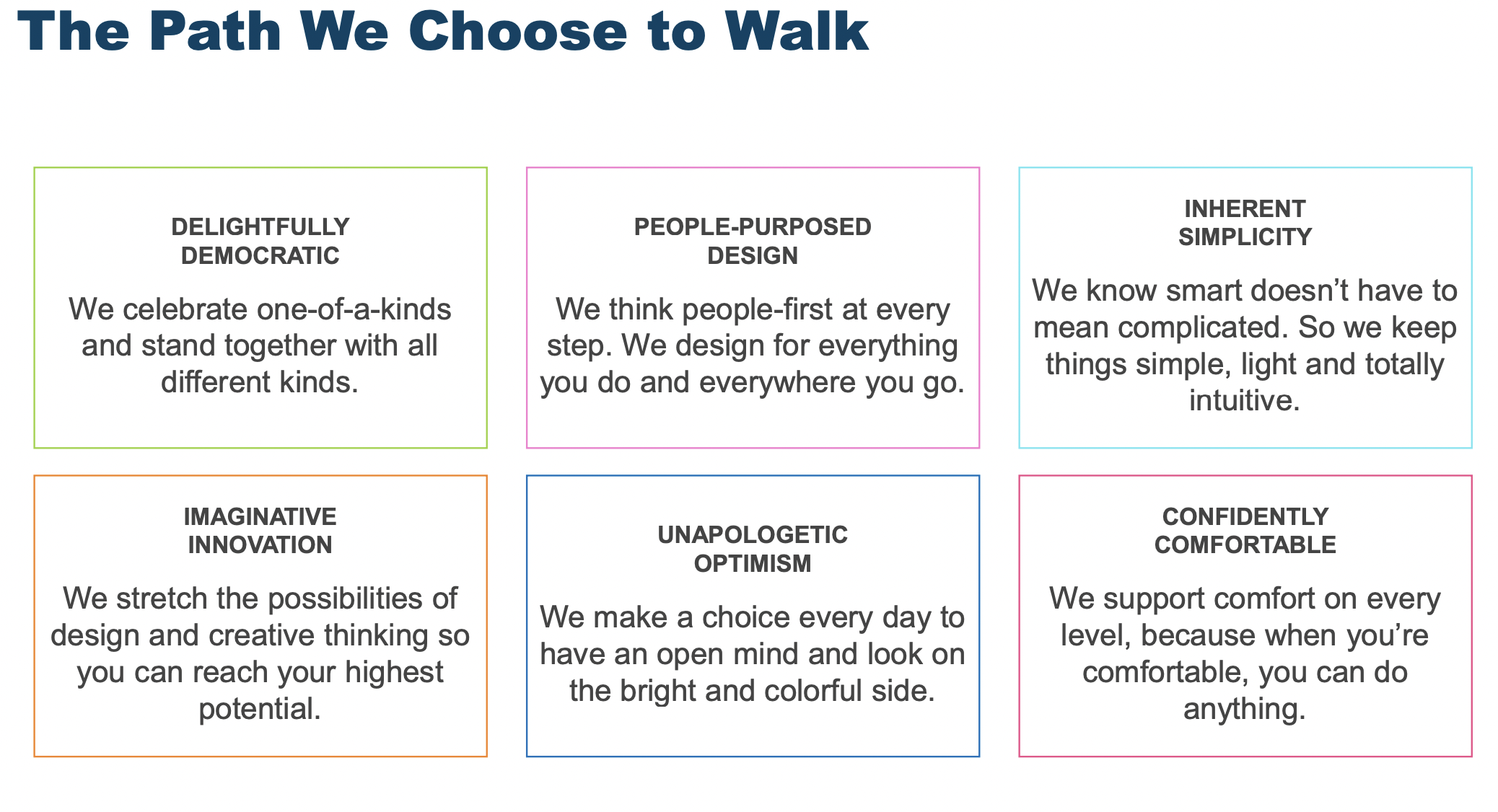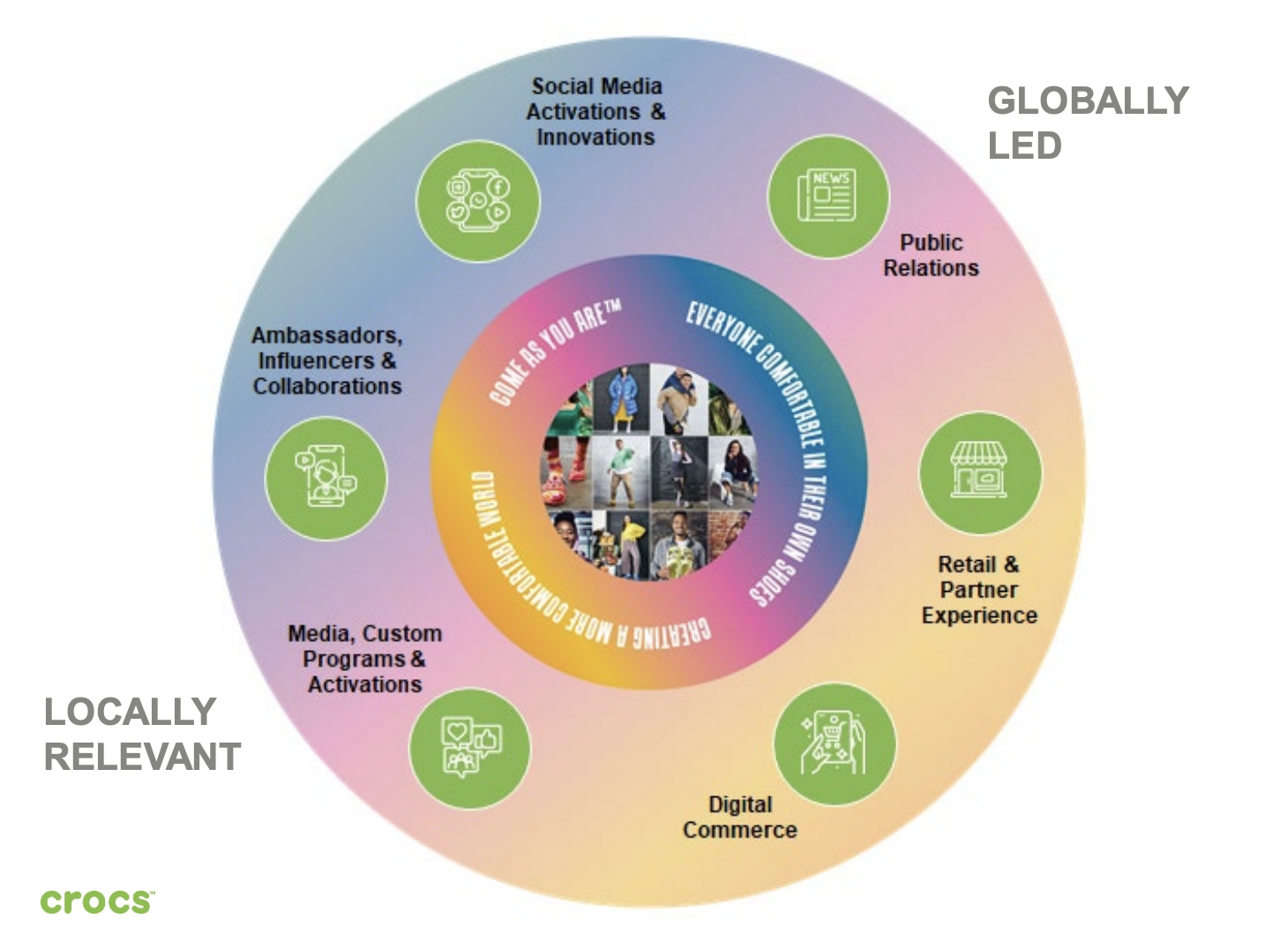Part
01
of one
Part
01
Crocs Company Analysis
Key Takeaways
- The Crocs brand was launched in 2002 and is currently available in 90 countries around the world. Since its launch, some have posited that the brand has become "the most loved and hated shoe of all time.
- "The brand's core commitment to inclusivity, individuality, and acceptance, coupled with a strong focus on innovation, has driven its strategy over the past 5-6 years. Crocs reported annual revenue of $2.3 billion in 2021 (+67% vs 2020) and was ranked #6 in Piper Sandler's 2022 "Taking Stock of Teens" survey.
- Digital investment is a key component of Crocs' growth strategy. The company expects digital to represent 50% of its brand revenues by 2026. Speaking about Crocs' digital investment and performance in 2021, CEO Andrew Rees says, "This year, we invested in our digital capabilities, including in the Crocs mobile app, global social platforms, such as Douyin, and digital talent across the globe. We’re confident these investments and our continued focus will drive digital growth globally over the long term."
- Speaking at Crocs' 2021 Investor Day, CMO Heidi Cooley emphasized the importance of digital to brand marketing efforts: "I'd actually be hard-pressed to name a campaign where social or digital innovation was not a critical component of our strategy. We dropped the Diplo collaboration through a live stream on Twitch. Our Justin Bieber collaboration had its own Snapchat lens. In Korea, we partnered with Universal Music and YouTubers to create a Come As You Are soundtrack featuring Jibbitz. And we even created a Crocs world in Minecraft to introduce our tie-dye collection."
- At the same investor conference, Adam Michaels, Crocs' Chief Digital Officer, talked about the importance of digital in driving personalized solutions and reaching new customers: "We'll continue to invest in the technologies that enable these experiences, including virtual waiting rooms and recently with our Lightning McQueen launch online drawings....We'll be investing in creating experiences that allow consumers to interact with Jibbitz in new and exciting ways, including through the use of virtual and augmented reality. We know that when consumers personalize their footwear with Jibbitz, they become more valuable to us through higher average order values....a lifetime value higher 2x higher than our regular consumers. Ultimately, our goal is to create an environment where personalization becomes the norm."
Introduction
The research below provides a Crocs company analysis, including its history, current performance, values and mission, strategic initiatives, customer target, digital strategy, and marketing technology strategy, some technology products and services currently used, and recent technology partnerships. We have also included relevant commentary on the company's digital strategy by CEO Andrew Rees and other senior leaders. A comprehensive list of Crocs' marketing tech stack was not readily available in the public domain, though we were able to uncover some high-level information, recent tech partnerships, and some insight regarding the company's technology strategy.
History
- The Crocs brand was launched in 2002 and is currently available in 90 countries around the world. The original founders were Scott Seamans, Lyndon Hanson, and George Boedecker.
- Crocs were "inspired by the Dutch clog" and originally focused on footwear that would appeal to boaters. Designed using patented Croslite "foam," the shoes were intended to deliver strong performance "on land and sea."
- Fashion historian Miranda DiCenzo Crocs' says that there was nothing like Crocs' "comfortable version of the Dutch clog" when the brand was launched. Since its launch, some have posited that the brand has become "the most loved and hated shoe of all time."
- In commenting on the cultural history of Crocs, fashion researcher Ellen Sampson says, "Crocs looked different and were made of material different from other shoes on the market in 2002. Think back to mainstream styles of the early 2000s: canvas slip-ons, like Vans; platform sandals, like Steve Madden, and mesh slip-ons, for example. There were blogs literally dedicated to hating Crocs, and they became a type of cultural phenomena."
- In 2006, Crocs acquired Jibbitz, charms used to personalize the shoes.
- By 2007, Crocs had become a mainstream brand by appealing to kids and their parents and embracing its unique style (embodied by ad campaigns such as "Ugly Can Be Beautiful").
- Rebounding from financial trouble in 2009 (and press, such as being named as one of Time's 50 worst inventions in 2010), the company has sought to devise a long-term sustainable growth strategy via marketing and innovation.
- In 2013, Crocs was named Company of the Year by the Consumer Goods Growth and Innovation Forum (CGT) for its "continued focus on global growth and product evolution," including new products, new marketing campaigns, an updated website, and mobile shopping capabilities.
- CEO Andrew Rees said in 2019 that "exploiting the tension between [brand] lovers and haters" was at the core of its strategy: "Our goal is not to make the haters love the brand. It's to exploit that extrinsic tension because it creates opportunity, it creates PR, it creates media, it creates interest. It creates a whole lot that would cost you a fortune to buy in other ways."
- Between 2016 and 2018, the high-fashion world began to embrace the Crocs brand, with partners including Christopher Kane (marble-streaked Crocs with crystal Jibbitz) and Balenciaga, a partnership that continues to present day (current "Crocs Pool" style collaboration campaign image shown below).
- Celebrity ambassador collaborations (Justin Bieber, Post Malone, Zooey Deschanel, Priyanka Chopra), another key component of the brand growth strategy, are based on authenticity. According to Croc's CMO, Heidi Cooley, "We don’t work with partners who aren’t authentic fans of the brand. We make sure that these influencers were already wearing our shoes before we approach them."
- The brand's commitment to inclusivity, individuality, and acceptance, coupled with a strong focus on innovation, has driven its strategy over the past 5-6 years. Cooley further emphasizes, "What connects our fans is that they’re inclusive...Because our shoe is still polarizing, it takes courage to raise your hand and wear Crocs, so they have this unified acceptance of each other." Crocs' current "Come as You Are" campaign showcases this commitment to individuality and celebrates "youthful uniqueness."
Current Performance
- Crocs reported annual revenue of $2.3 billion in 2021 (+67% vs 2020) and continued this growth trajectory into Q1 2022 (+47%).
- Crocs offers a variety of clogs, slides, sandals, and flip flops designed for a variety of users (men's, women's, and kid's) and Jibbitz (charms designed to personalize Crocs).
- Crocs acquired the casual footwear brand, HeyDude in February 2022.
- The Crocs brand accounts for 73% of total company revenue (HeyDude accounts for the remaining 27%). DTC channels represent 35% of revenue, while digital sales account for 32% of revenue.
- The Crocs brand was ranked #6 in Piper Sandler's 2022 "Taking Stock of Teens" survey.
- Some interesting facts about the brand include its design (13 holes on each shoe), the origin of its name (the brand is named after the crocodile), the number of shoes sold globally since 2002 (850 million), and its unique collaborations (such as the "fun and fashionable take on our classic clog", KFC Crocs, shown below).
Values and Mission
- The Crocs brand promises a simple approach to offering comfort, style, and value, noting that "comfort is the key to happiness" and "makes the world a happier place."
- Its stated vision underscores its commitment to uniqueness and individuality: "Everyone comfortable in their own shoes."
- In addition to innovation, comfort, and simplicity, company values include celebrating individuality ("celebrating one-of-a-kinds"), optimism, and a people-first design.
Strategic Initiatives
- Strategic initiatives include digital investment, growing Sandals and Jibbitz revenues, Asia-Pacific growth (and more specifically, business growth in China), and continuing focus on innovative product launches and marketing.
- In its most recent quarterly review, the company highlighted 2 innovations ("Cozzy lined 2 strap sandal and Literide 360") as well as digital marketing campaigns (Spotify, Karol G).
- The company is also committed to sustainable, socially conscious, and transparent growth. With a goal of achieving net-zero by 2030 and a "50% reduction in its carbon footprint per pair of Crocs™ shoes by 2030", the company has introduced a bio-based Croslite material, emphasized donation, recycling, and "re-commerce" programs, and is exploring sustainable packaging alternatives.
Customers
- Crocs considers itself a "democratic brand," appealing to a diverse range of consumers, including men, women, and kids, with similar representation across gender.
- In 2019, CEO Rees said the core US consumer target was primarily "Feel Goods," skewing towards females, 35-45, and households with kids.
- In Asia, the "Explorers" segment is more prevalent. This segment is younger (25-30), urban, with lifestyle and fashion considerations driving purchase.
- More recently, as Crocs has embraced celebrity ambassador partnerships, the brand has become more popular among younger consumers (Gen Z).
- The company now considers millennials and Gen Z its core consumers, aligning with the "ethos" of the brand. According to CMO Heidi Cooley, "This generation is about self-expression, community and digital-first. That’s who we are."
Digital Strategy Highlights
- Digital investment is a key component of Crocs' growth strategy. The company expects digital to represent 50% of its brand revenues by 2026.
- "Enhancing digital capabilities" is also highlighted as a key growth initiative for its recent HeyDude brand acquisition.
- The company's digital-first distribution strategy includes its website, third-party marketplaces, and e-tailers.
- Crocs recently launched a digital app in 2021. In addition to elevating DTC and digital sales, the company expects the app to offer an enhanced omnichannel shopper experience. The app includes VR technology-driven features, such as "try before you buy" as well as influencer content (style tips, videos) and the ability to "bridge" digital with physical stores via a BOPIS (buy online, pick up in-store) sales model.
- In addition to digital commerce, social media innovation is a key pillar of its marketing strategy. The company highlights 5.3 million followers on its social accounts globally.
- Examples of social communication and user-generated content are shown below (highlighted by Crocs as "best-in-class" marketing activations.
- Cooley notes the importance of digital to its marketing efforts: "I'd actually be hard-pressed to name a campaign where social or digital innovation was not a critical component of our strategy. We dropped the Diplo collaboration through a live stream on Twitch. Our Justin Bieber collaboration had its own Snapchat lens. In Korea, we partnered with Universal Music and YouTubers to create a Come As You Are soundtrack featuring Jibbitz. And we even created a Crocs world in Minecraft to introduce our tie-dye collection."
- Trend forecaster Marie-Michèle Larivée comments on the importance of social media to Crocs' rise: "The continuous rise of social media also has to do with the rise of Crocs. Referring to the waist-down ironic style, people post different angles of the camera and play with formal and non-formal wear. The highly visual aspect of Crocs—its materials and colors and a significant symbol of humor—has amplified the [conversation].”
CEO and Senior-Level Commentary
- In 2019, Rees commented on the company's digital focus: "The consumer is shifting very dramatically to purchasing digitally. And I think we’ve been very front-foot forward in that not only in terms of our own websites and how we go to market directly with consumers, but probably even more importantly how we treat global marketplaces like Amazon, Tmall, etc., and how we work with them to reach a very broad range of consumers.”
- Crocs "intensified" its digital strategy during the pandemic, increasing investment in digital channels (particularly paid search). Adam Michaels, Chief Digital Officer at Crocs, said of the strategy, "Paid search is one of our most important digital advertising channels. Customer acquisition is, like for many brands, a huge part of our current and go-forward strategy and paid search allows us to target and grow our customer acquisition efforts, more than any other channel. We leverage paid search to find more consumers, and that has been one of our highest-performing channels from a ROI (returns on investment) standpoint. Paid search is one of our highest-performing channels globally."
- In commenting on its 2021 app launch, Michaels says, "It’s a very competitive landscape. We really thought that for an app to be successful and to really stand out, it had to be more than just transactional. We had to find ways to make it something people want to engage with.”
- Speaking about Crocs' digital investment and performance in 2021, Rees says, "This year, we invested in our digital capabilities, including in the Crocs mobile app, global social platforms, such as Douyin, and digital talent across the globe. We’re confident these investments and our continued focus will drive digital growth globally over the long term.
- Michaels comments further on the expansion of Crocs' digital ecosystem: "As the brand has grown, so too has our digital ecosystem. From what was a channel-driven strategy with a narrow focus on crocs.com to a much more consumer-centric strategy, leveraging a wide spectrum of digital and physical touch points. Over the past several years, we've added over a dozen marketplaces around the world, including Rakuten in Japan, Wildberries in Russia, Zalando in Europe and Flipkart in India. We've also enhanced our presence on globally and locally relevant social channels like TikTok, WeChat in China, and Line in Japan."
- Rees further emphasizes the relevance of digital when discussing the HeyDude acquisition, with Rees commenting to investors, "Like Crocs, Hey Dude has a digital-first approach and high digital penetration."
Marketing Technology
- Crocs' digital team is responsible for "leveraging analytics, digital marketing, new technology and social media" to deliver "personalized inspiration to purchase the amazing Crocs brand."
- The digital team addresses digital marketing, merchandising, technology and operations (e.g., front and back end development), e-tail best practices (assortment and pricing), user experience, partnerships and collaborations (brand commerce), and analytics.
- In September 2021, Michaels talked about the importance of digital in driving personalized solutions and reaching new customers: "We'll continue to invest in the technologies that enable these experiences, including virtual waiting rooms and recently with our Lightning McQueen launch online drawings....We'll be investing in creating experiences that allow consumers to interact with Jibbitz in new and exciting ways, including through the use of virtual and augmented reality. We know that when consumers personalize their footwear with Jibbitz, they become more valuable to us through higher average order values, and as Michelle mentioned, a lifetime value higher 2x higher than our regular consumers. Ultimately, our goal is to create an environment where personalization becomes the norm."
- In 2021, the company partnered with Cloudinary to optimize and simplify its image management process and provide a " more engaging, visual-first customer experience."
- The company also announced the deployment of Aptos cloud-based "customer engagement and merchandise management solutions across its global retail enterprise." Doug Goehl, Vice President, Global Retail IT and People Systems for Crocs says of the technology initiative, "By embarking on this technology modernization journey, Crocs now has a unified retail platform that allows us to gather deeper insights, enabling the brand to serve our consumers better, deliver the right products to the right stores at the right time, and operate our business in a more profitable, data-driven manner."
- The company has expanded its digital payment solutions globally with Afterpay.
- Dow and Crocs collaborated in 2021 to leverage Dow technology in its products to reduce carbon emissions.
- More generally, BuiltWith notes Crocs is "actively using 99 technologies for its website, including SPF, WordPress, and Font AwesomeResearch Strategy." G2 stack also reports that Crocs uses "37 technology products and services including HTML5, Google Analytics, and jQuery."
Research Strategy
For this research on Crocs Company Analysis, we leveraged the most reputable sources in the public domain, including the Crocs website, social channels, investor presentations, press releases, news articles (e.g., W Magazine, Fast Company, Footwear News, Slate), and interviews with the company CEO, Andrew Rees, and other senior executives. Direct quotes were provided from Rees as well as other senior executives including Adam Michaels, Chief Digital Officer at Crocs, Doug Goehl, Vice President, Global Retail IT and People Systems for Crocs, and CMO, Heidi Cooley, all of whom provided relevant insights to the company's digital strategy. Detail on the marketing tech stack was less available in the public domain. We did attempt to provide the company's perspective on its marketing technology solutions and strategy, some high-level insight on technology products and services provided by Crunchbase and G2, and some recent specific marketing technology partnerships and launches.







